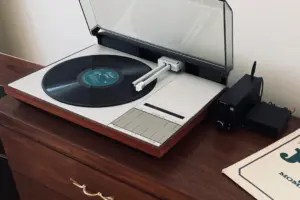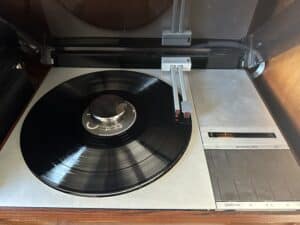Forum Replies Created
-
AuthorPosts
-
 BRONZE Member
BRONZE MemberPaul, in your first post you stated that you just purchased this turntable and it worked until you began taking it apart and lubricating it. Can you please confirm the details as to what worked on it and how you reached that connclusion.
NEXT, as I have stated earlier, no lights should be coming on when you plug the turntable in. On that model nothing should happen until you press the Start button. If you Press and Hold the Start button the arm should move to the center of the table and then reverse and come back. During that process the platter speed will change from 33 to 45. Please put all the belts and platters on and perform this test and report back the specifics of how it behaves.
NEXT put on a record and Press and Release the start button. Report if and where to the arm moves, does the turntable spin and at which speed, and whether the arm lowers.
With the above information, we can begin giving you meaningful directions.
 BRONZE Member
BRONZE MemberPaul, not sure why you are ignoring my troubleshooting questions. You’ve come here for help and collectively we have decades of experience; however, from what you have posted you are not approaching this systematically. We are trying to guide you by establishing a functional baseline – thus the questions.
Per the manual, there is a relay that switches between speeds based upon either the control panel switch or an optical pulse generated by the tonearm carriage position.
 BRONZE Member
BRONZE MemberI’d start with replacing C17 as that is too much ripple for a 13vDC line. Are the diodes mounted above the the board? If not then that heat is not normal. How much power is the who player drawing when playing? It should be no more that 20-25W.
 BRONZE Member
BRONZE MemberYou have multiple issues which is making troubleshooting this online very difficult.
First Problem: Plugging in the turntable should NOT cause any lights to turn on on motors to run. Since the 33 one is that means that the SO switch is not making proper contact. Either the switch’s spring has come off or the slide is not causing it to close at its rest position.
Second Problem: Missing Servo Belt: The belt that drives the threaded shaft is not installed and needs to be to properly test the arm movement. Once this is installed then my question above about pressing and holding Start is relevant.
Lets get this working first before removing any parts or making adjustments.
 BRONZE Member
BRONZE MemberWhen you press start, the inward movement of the tonearm activates a switch on the slide PC board that causes it to remain on. If that is not happening you will get that problem. If you keep holding the Start button, does the arm advance to the middle as long as you hold it as it should?
 BRONZE Member
BRONZE MemberIt sounds to me like the servo belt is slipping due to wear or the pulley’s lock screw support is cracked. You can also have this problem is the threaded rod is not parallel with he supporting rods.
 BRONZE Member
BRONZE MemberI don’t believe so. The stylus on an SP14 includes the outer shell as an integral part of it.
 BRONZE Member
BRONZE MemberThe SP1&2 used a different stylus replacement form from later modeis. One source is https://www.dacapoaudio.com/908-bang-olufsen-sp-1-sp-2.html.
 BRONZE Member
BRONZE MemberLucy, welcome. Your turntable is over 50 years old and likely needs at least a new stylus and a stereo amplifier or receiver that has a Phono input or a separate phono preamplifier to connect to the former. To find service possibilities, you’ll need to share your location as that model was sold globally.
9 August 2025 at 04:22 in reply to: How to get rid of 50hz noise (BeoGram 7000 connected to Almando Multiplay v3) #68662 BRONZE Member
BRONZE MemberI am not familiar with the Armando; however, CAT7 cable is not intended for analog audio use even when it’s shielded. Frequently, a hum issue will be the result of either a coupling problem due to proximity of AC mains lines when run with the CAT7 in the walls or a ground differential issue or loop between where your turntable is plugged in than your system across the room. Since the RIAA amplifier in the 7000 is not a balanced output there is no common mode rejection along the signal run. I would approach determining which type of hum you have by running a CAT7 cable across the room in lieu of you in wall set up. If the hum goes away you have in-wall coupling which may be mitigated by using isolation line transformers to convert your single ended connection to balanced on bot sides. If the hum is sill there you then have an AC mains grounding issue, and you need to disconnect the grounded shield from the Almando end. You also might try reversing the mains plug on one side if its a 2-prong one.
 BRONZE Member
BRONZE MemberCraig, thanks for the kind words. Here is a photo of one with the Grado Signature. I would also replace the tonearm wiring with silver wire and the phono leads with Varian Audio cables. Finally, there was an optional PhonoAmp board that replaced the muting one with an onboard DC-DC power supply to give it +/-15V.
 BRONZE Member
BRONZE MemberWhat you have is the packing box of the cartridge that would come when it was included with the turntable. They provided specific models with specific turntables. The retail packaging for the cartridge was much larger and had the model on it. This cartridge is upside down hiding its model and the cantilever looks skewed, so I would avoid.
 BRONZE Member
BRONZE MemberNebojsa is correct. I was a B&O dealer back then.
 BRONZE Member
BRONZE Member BRONZE Member
BRONZE MemberI believe you can find Millard equivalents as FCH111 for the 131/111 chips and FCH191 for the 101. I have not tried these but they are listed. It’s very rare for these to fail in normal use.
 BRONZE Member
BRONZE MemberI was not referring to to the solenoid screw adjustments you referenced. The correct one to address the OP’s issue is the adjacent damper cylinder screw that regulates the air flow as its piston prevents the arm from dropping with a thump.
 BRONZE Member
BRONZE MemberWhile there is no muting delay adjustment as on the later models, you should be able to eliminate the thump by adjusting the damper cylinder set screw. The are should lower in between 1 and 1.5secs.
 BRONZE Member
BRONZE MemberI would focus on the components around the 1TR14 portion of the electronic switch and I would also reflow solder connections in that area.
 BRONZE Member
BRONZE Member1D16 is a Zener diode that is supposed to set the base voltage of 1TR5 which turns on the lamp in the detector arm. If it shorts it not only will not keep the lamp off but will pull down the 22V rail that will impact other circuits such as the solenoid driver. Glad you got it working again.
 BRONZE Member
BRONZE MemberFirst, if you are only getting 18v then there is still a power supply problem. I would work backwards to see where the voltage drop is occurring. You could still have a bad cap or transistor. As to 1R36, you may have a bad Zener diode, 1D17.
-
AuthorPosts


